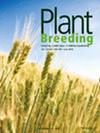Prospects for tritordeum (×Tritordeum martinii A. Pujadas, Nothosp. Nov.) cereal breeding: Key points for future challenges
IF 1.8
4区 农林科学
Q2 AGRONOMY
引用次数: 0
Abstract
Tritordeum is the new cereal derived from crosses between the wild barley三尖杉(×Tritordeum martinii A. Pujadas, Nothosp. Nov.)谷物育种的前景:未来挑战的要点
Tritordeum 是野生大麦 Hordeum chilense Roem. et Schultz.与硬质小麦或面包小麦杂交产生的新谷物,分别为六倍体和八倍体 Tritordeum。三叶草作为一种作物能否取得成功,取决于其育种计划是否有效。在这项工作中,我们筛选了谷物类胡萝卜素含量和病害易感性方面的先进三系小麦新品系,以分析当前育种策略的影响,并确定其优势和可能的局限性,以应对未来的挑战。我们的结论是,谷物类胡萝卜素含量是三疣梭子蟹商业化的主要优势,不仅应通过利用 H. chilense 的多样性,而且还应结合硬质小麦的有益等位基因来加强谷物类胡萝卜素含量的选育。此外,必须将小麦 A 和 B 基因组中抗茎锈病的基因纳入三叶草育种计划。最后,在选择脱粒性时,应采用标记辅助选择方法,优先选择没有染色体替换的三叶草。
本文章由计算机程序翻译,如有差异,请以英文原文为准。
求助全文
约1分钟内获得全文
求助全文
来源期刊

Plant Breeding
农林科学-农艺学
CiteScore
4.40
自引率
5.00%
发文量
74
审稿时长
3.0 months
期刊介绍:
PLANT BREEDING publishes full-length original manuscripts and review articles on all aspects of plant improvement, breeding methodologies, and genetics to include qualitative and quantitative inheritance and genomics of major crop species. PLANT BREEDING provides readers with cutting-edge information on use of molecular techniques and genomics as they relate to improving gain from selection. Since its subject matter embraces all aspects of crop improvement, its content is sought after by both industry and academia. Fields of interest: Genetics of cultivated plants as well as research in practical plant breeding.
 求助内容:
求助内容: 应助结果提醒方式:
应助结果提醒方式:


